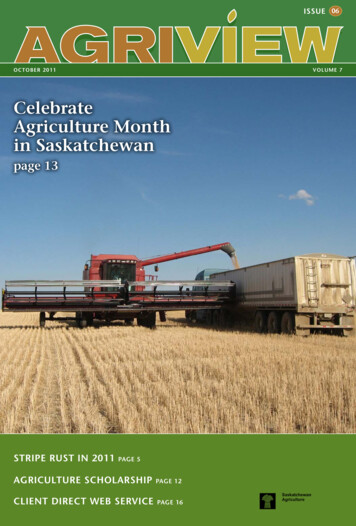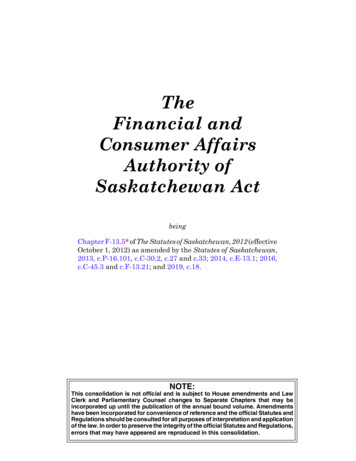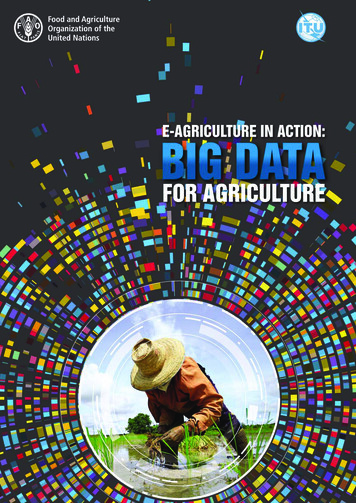
Transcription
06OCTOBER 2011VOLUME 7CelebrateAgriculture Monthin Saskatchewanpage 13stripe rust in 2011page 5agriculture scholarshipPAGE 12client direct web servicePAGE 16
Minister’s MessageOctober has once again been proclaimed as Agriculture Month in Saskatchewan. Agriculture Month isa time to recognize the important role farm and ranch families play in our province.Our government sincerely appreciates everything our farm and ranch families do from makingsignificant contributions to our economy to putting food on our plates.We have worked hard to address the needs of our producers in Saskatchewan. This includes implementingthe Excess Moisture Program and the Saskatchewan Feed and Forage Program in both 2010 and 2011 tohelp producers dealing with flooding. In total, over 600 million has been made available to producers overthe last two years to assist with excess moisture challenges.We have also introduced several new programs, such as the Farm and Ranch Water Infrastructure Program, the Crown Land SaleProgram, and compensation for livestock losses caused by wildlife.We have also focused on improving our services for producers. The previous government closed 31 rural offices throughoutSaskatchewan, which left a substantial gap in the services available to farmers and ranchers. Our government recently openedseven new Saskatchewan Agriculture satellite offices in Wadena, Estevan, Moosomin, Lloydminster, Assiniboia, Shaunavon andMeadow Lake. These offices are in addition to our 10 existing offices where producers can access advice and information on crops,forages, livestock and farm business management.We have also brought the AgriStability program to Saskatchewan to be administered by the Saskatchewan Crop InsuranceCorporation. We are working to make the program more timely and reliable for producers, while providing local service throughour Crop Insurance offices.We have also worked to improve the Crop Insurance Program, including providing the four largest budgets and average coveragelevels in the program’s history. The average coverage level in 2011 is 173 per acre, which is nearly double the average coveragelevel in 2007. In addition, the Unseeded Acreage (USA) Benefit was increased in 2011 from 50 to 70 per eligible acre. Thisresulted in a record high 329 million in USA Benefits to assist producers with land they were unable to seed because of excessmoisture this year.Agriculture remains the backbone of our province. I want to thank our farm and ranch families, and everyone involved inagriculture in Saskatchewan, for their hard work and dedication to our industry and province.Sincerely,Bob BjornerudSowing the Seeds for 2012 – Attend the SaskatchewanGreen Trades Conferenceby Glen Sweetman, PAgProvincial Specialist, Nursery and Greenhouse CropsCrops BranchThe Saskatchewan Green Trades Conference will be held fromNov. 11-12 in Saskatoon.There will be five concurrent sessions featuring top industryspeakers from across North America. Conference topics include:information on production techniques and tools; pestmanagement; new varieties; research and marketing, and muchmore. The talks are beneficial to all levels of producers, includingpotential producers and seasoned professionals. The conference isalso a valuable training opportunity for staff working in thehorticulture industry.Conference partners include the Saskatchewan GreenhouseGrowers’ Association, Saskatchewan Vegetable Growers’ Association,Saskatchewan Seed Potato Growers’ Association, SaskatchewanParks and Recreation Association, and the Saskatchewan Nurseryand Landscape Association. These organizations serve the province’sgreenhouse bedding plant producers, greenhouse and fieldvegetable producers, potato producers, market gardeners andgarden, nursery and landscape centres.Pre-conference workshops are scheduled for Nov. 10 and include:Integrated Pest Management; A New Era -Speaking and Selling toToday’s Consumer; and, Improved Grounds Maintenance. Theseworkshops are up to four hours long, which allows experts the timeto delve into topics in greater depth than at the general sessions.The Saskatchewan Green Trades Conference continues to grow insize, membership and popularity. Informative speakers, a fantastictrade show and ample opportunity to network make this a popularevent.For more informationVisit the conference website at www.sgtc.ca.Presentation to IndustryPrune the Suckers From Your BusinessPresenter Glen Sweetman, PAgSuckers drain the resources from plants and businesses;they provide limited benefits for the resources used. Glenwill talk about fixing the small things that can add up to bigefficiencies in your greenhouse. Join in and plan to prune.
STORY SNAPSHOTS15657Fall banding nitrogenPerennial forage rotationsWildlife compensation program changesObsolete pesticide collectionTABLE OF CONTENTScroPS4Livestock8crown landsResearch06OCTOBER 201111VOLUME 7CelebrateAgriculture Monthin Saskatchewanprograms and servicespage 13events calendarSTRIPE RUST IN 201191216PAGE 5AGRICULTURE SCHOLARSHIPPAGE 11CLIENT DIRECT WEB SERVICEPAGE 16Cover: Harvesting in Saskatchewan.Correction notice: In the September issue ofAgriview, the cover description should haveread, “Jason Brown from Brown BrothersWelding and Fabrication.” We regret the error.AGRIVIEW is published by the Communications Branch of Saskatchewan Agriculture for Saskatchewan farmers and farmand food organizations. For more information, call 306-787-5160 or e-mail agriview@gov.sk.ca.To view this publication online, visit R 20113
CROPSPartnering for pest managementby Glen Sweetman, PAgProvincial Specialist, Nursery and Greenhouse CropsCrops BranchThe SSGA-ADOPT demonstration is being held at the University ofSaskatchewan Agriculture Greenhouse on Nov. 10, 2011, from 9 a.m.to 4 p.m. This is an informative self-guided tour through differentproduction systems.The greenhouses arelocated at 111 North Roadon the University ofSaskatchewan campus (justoff of Perimeter Road andnorth of the CanadianLight Source Synchrotron).The SaskatchewanGreenhouse GrowersAssociation (SGGA) willteam-up with severalpartners including theUniversity of Saskatchewan,Olds College, SaskatchewanMinistry of Agriculture andindustry suppliers toprovide a learningopportunity for insectmanagement ingreenhouses.The Integrated PestManagementDemonstration funded bythe AgriculturalDemonstration of Practicesand Technologies (ADOPT)will showcase the use of biological, chemical and organic controlmethods for pest management on greenhouse crops. This is anopportunity for producers to learn how to scout and identify insects,and to identify new technologies and methods that can beincorporated into their existing pest management systems.The goal of the ADOPT demonstration is to provide information ondifferent production methodologies and how to use the tools of pestmanagement to their fullest potential.If you are seeking a morehands-on experience inGreenhouse Integrated PestManagement, the SGGA isalso offering a moreintensive workshop as partof their annual conference(The Green TradesConference). Preregistration is required forthe conference workshop.For more information Contact Shannon Fraser-Hansen, Managing Director, SGGA at(306) 259-4809; or E-mail Shannon at srdfrahan@sasktel.net; or Contact Glen Sweetman at (306) 787-6606 ore-mail at glen.sweetman@gov.sk.ca; or Visit www.sgtc.ca.Alfalfa: A Solution to Saline Soilsby Gary Kruger, PAgIrrigation AgrologistIrrigation Branchproject support the conclusions from the laboratory research conductedby Dr. Harold Steppuhn and the salt-tolerant alfalfa lines may soon bethe farmer’s weapon of choice against waterlogged and saline fields.The results so far:Farmers often have to cope with the production challenges presentedby salinity and waterlogging on their irrigated soils. Fortunately,forages such as alfalfa remain an excellent crop choice that may eventhrive in such soils. That is why the Irrigation Crop DiversificationCorporation (ICDC) funds several forage demonstration projects insupport of affected farmers.Alfalfa is one forage crop that is not only productive on these soils butalso uses more water than many other crop choices. The alfalfa plant isalso long-lived and deep-rooted, giving the crop the ability to toleratesalinity and even to lower the water table over the landscape.Currently, an ICDC project at the Canada-Saskatchewan IrrigationDiversification Center (CSIDC) in Outlook is comparing three salttolerant lines of alfalfa. These lines have been identified by workconducted at the Salt Lab of the Swift Current Semiarid PrairieAgricultural Research Centre. The purpose of conducting this fielddemonstration in Outlook is to “field-test” or duplicate the findings onthese salt-tolerant lines that were first observed in the laboratory.Table 1: Irrigated alfalfa forage yield at CSIDC for the first two cutsharvested in 2011*Variety1st cut (t/ac)2nd cut (t/ac)Total toAug 4 (t/ac)**HaloCW064027AC .413.963.693.40First year of production after establishment year.Based on an average of eight quarter-square-metre samples per replicate fromtwo replicates. (total of 16 samples)***For more information Contact Gary Kruger, Irrigation Agrologist at gary.kruger@gov.sk.ca;or Visit our website at www.agriculture.gov.sk.ca.Two of the newer lines of alfalfa have been recently released under thevariety names of Halo and Bridgeview marketed by Viterra and Secanrespectively. As of today, preliminary field test results from the ICDC4OCTOBER 2011
CROPSFall banding nitrogen fertilizer helps savetime in the springby Patrick Mooleki, PhD, PAgSoil/Nutrient Management SpecialistRegional Services Branchandby Ken Panchuk, PAgProvincial Specialist, SoilsCrops BranchFall banding of nitrogen fits the 4R nutrient stewardship conceptadvocated by the fertilizer industry. This concept emphasizes applyingfertilizer using the Right source, at the Right rate, at the Right time andin the Right place.For more information Call the Regional Crops Specialist at your nearest SaskatchewanAgriculture regional office; or Contact the Agriculture Knowledge Centre at 1-866-457-2377.Banding nitrogen fertilizer in the fall means producers have one lesschore to do in the spring, relieving some of the time pressure andreducing concerns about seed-placed nitrogen for single-shoot openerseeding systems. It is also an excellent fertilizer management practice.Banding urea (46-0-0) and anhydrous ammonia (82-0-0) can begin oncethe soil temperature has cooled to below 10C. In the soil, both urea andanhydrous ammonia convert to ammonium that is held on soil andorganic matter by adsorption until the soil warms up in spring.Banding into the soil also minimizes volatilization losses andsignificantly slows down the nitrification process by creating a specialenvironment within the band that minimizes the conversion ofammonium to nitrate.Use information obtained from soil test results to determine the rightrates of nutrients to apply. However, if results are not available,calculate about three-quarters of the nitrogen you expect to apply andband it in the fall. Then apply the balance in the spring as determinedby the soil test. Determine subsoil moisture in late fall and again inearly spring, if needed, to help determine a realistic target yield. Arealistic target yield and soil test information are used together to makefinal adjustments to nitrogen and other nutrient requirements in timefor seeding.Banding nitrogen in the fall.Why so much Stripe Rust in 2011?by Faye Dokken-Bouchard, MSc., AAgProvincial Specialist, Plant DiseaseCrops BranchStripe rust (yellow rust) disease was widespread on Saskatchewanwheat in 2011.The disease was first noticed in early summer on winter wheat growingin eastern Saskatchewan. By the end of the crop season it was found onwinter, spring and durum wheat throughout the province. In some cases,foliar-applied fungicides were used to protect the flag leaf from severeinfection when severity warranted application.Stripe rust isn’t common to Saskatchewan because it prefers highhumidity and cool night temperatures for infection. While conditionsmay have been conducive for stripe rust disease in 2011, it appears thereis more to it than that.Stripe rust on wheat has actually been appearing more frequently inSaskatchewan since 2000. This may be due to climate change as well asadaptation by this genetically diverse fungus. In 2006, relatively highlevels of stripe rust were observed in southeastern Saskatchewan.However, from 2007 to 2010, stripe rust was generally found in only afew fields at trace levels in the province.The risk that stripe rust poses depends on the geographical range andamount of over-wintering fall infections. Normally, over-wintering isOCTOBER 2011limited to the southern United States. However, if conditions are mildenough farther north, the disease will survive; it will show up earlier inSaskatchewan; and, it will have more time to spread.Snow cover may have insulated infected winter wheat plants last winter,thereby allowing the disease to survive in Saskatchewan. This can resultin more devastation than if it was limited to inoculum arriving on windcurrents from the southern United States later in the season. The severityof the disease also depends on humidity and temperature in all wheatgrowing regions, as high humidity and cool night temperatures providefavourable conditions for the build-up of the inoculum.Genetic resistance and stage of crop development during infection willalso impact potential damage. Because stripe rust is a relatively newproblem in Canada, genetic resistance has only recently become apriority for plant breeders until recently. Resistance to stripe rust will be arequirement for registration of wheat varieties in Canada by 2017.Preliminary stripe rust ratings can be found in the 2011 Varieties ofGrain Crops publication located on the Ministry of Agriculture websiteat www.agriculture.gov.sk.ca under the Crops heading. This informationwill be strengthened as researchers learn more about the disease.For more information Contact Faye Dokken-Bouchard at (306) 787-4671 or e-mailfaye.dokken-bouchard@gov.sk.ca; or Contact a regional crops specialist.5
CROPSWinter annual weeds are wasting yourresourcesby Clark Brenzil, PAgProvincial Specialist, Weed ControlCrops BranchThe best time to apply 2,4-D or MCPA herbicides at 115 grams acidequivalent per acre for winter annual weeds such as stinkweed,flixweed or shepherd’s-purse in the fall is just before freeze-up. ThisWinter annual weeds germinate in the fall, survive through thewinter, and then resume growth early in the spring. Winterannuals have a big advantage over spring germinating crops sincethey are often finished flowering and are beginning to mature as cropsare emerging. This means they are using up valuable resources thatwould otherwise be available for the emerging crop and are, inessence, competing with the crop even before it is seeded.Controlling winter annual weeds as early as possible will help preventthe competitive influence that they have on crops prior to seeding.University of Saskatchewan research has shown that when pre-seedburnoff herbicide was applied early in the season, both early andlate-seeded crops yielded roughly the same.But when the burnoff on later seeded crops was done just ahead ofseeding, there was significantly lower yield compared to the lateseeded crops where the burnoff herbicide was applied early in thespring.This early application benefit can also be achieved by controllingwinter annual weeds in the fall. Winter annual weeds germinate inlate summer or early fall when temperatures begin to cool and usuallycontinue until freeze-up. As a result, the timing of fall 2,4-D andMCPA application for winter annual weed control is much later thanherbicides applied for perennial weed control.Stinkweed rosette in field.way little weed emergence happens after herbicide application. Theseherbicides are not effective on narrow-leaved hawk’s-beard. Springapplication is better suited for this weed.For more information See the 2011 Guide to Crop Protection; or Contact the Agriculture Knowledge Centre at 1-866-457-2377.Obsolete Pesticide Collection coming to Saskatchewanby Richard Wilkins, BSc., M.B.A.Provincial Specialist, Pesticide RegulatoryCrops BranchFor more information Visit the Obsolete Pesticide Collection Campaign atwww.cleanfarms.ca.All chemicals, including agricultural crop protection products, needto be handled with caution. But what happens when theseproducts are no longer wanted due to age, condition, or they can nolonger be used due to registration status? They must be disposed ofproperly to reduce possible risks to persons, animals (livestock, petsand wildlife) and the environment.Improper pesticide disposal can impact water and soil resources. Somebanned pesticides, such as DDT, are environmentally persistent,meaning they do not break down quickly and can bio-accumulate inanimals.Because of these risks, it is important to properly dispose of unwantedpesticides in an environmentally sound manner. CleanFarms Inc., theStewardship Division of CropLife Canada, is offering an industry-ledExtended Producer Responsibility program to collect unwantedagricultural pesticides to help address this issue.In late October, CleanFarms will be operating an Obsolete PesticideCollection Campaign for the southern half of the province. Theprogram will run from Oct. 25 - 27, 2011 at 18 different locationswhere producers will be able to drop off any unwanted pesticides andempty strychnine bottles at no cost.This will be the third time CropLife / CleanFarms has held thisprogram in Saskatchewan to reduce the inventory of unwantedpesticides. A sweep of the northern part of the province will followin 2012.6Obsolete pesticide in storage. Photo: ViterraOCTOBER 2011
CROPSPerennial legumes benefit crop rotationsby Michel Tremblay, PAgProvincial Specialist, Forage CropsCrops BranchAcrop rotation including forage legumes can be a usefulmanagement strategy to increase availability of soil nitrogen toannual crops, potentially reducing the need for commercial fertilizer.Rhizobium bacteria works with legume crops to take nitrogen from thesoil air and convert it to ammonium, a form useable by plants. Whenlegume stands are terminated, the legume residue decomposes andslowly releases nitrogen and other nutrients to subsequent crops inthe rotation.The amount of nitrogen fixed by legumes varies substantiallydepending on the legume species, soil and environmental conditions.Well nodulated alfalfa fixes from 100 to 267 lb/acre (114-300 kg/ha) ofnitrogen annually, depending on growing conditions. Good soilmoisture levels result in enhanced nitrogen fixation.moisture, temperature and other soil conditions also impact microbialactivity and directly influence nitrogen mineralization.Estimates of mineralization are approximately 20 per cent of fixednitrogen in a dry year, and up to 80 per cent in a moist year. Typically,it takes three or more years for the majority of nitrogen to be releasedfrom decomposing alfalfa residue.Alfalfa productivity can begin to decline after five years due to standthinning, disease, winter injury, weeds, rodents and nutrientdeficiencies. Nearly any environmental factor that negativelyinfluences the growth of the legume plant will reduce nitrogenfixation. To maximize the benefits of perennial forages in an extendedrotation with annual crops, alfalfa fields should be removed afterapproximately five years.For more information Contact Michel Tremblay, PAg, Provincial Specialist, Forage Crops,Crops Branch at (306) 787-7712.When terminated prior to harvest, alfalfa can return 45 to 110 lb/acre(41-101 kg/ha) nitrogen to the soil. The rate at which the nitrogenbecomes available to following crops varies with the amount ofnitrogen fixed by the legume and the rate of decomposition of legumecrop residues.The nitrogen mineralization rate is influenced by the residue amount(forage legume residue can contribute 44 to 77 lb [20-35 kg] nitrogenper tonne of forage produced) and the carbon/nitrogen ratio (carbon/nitrogen ratios influence the rate of nitrogen release, with lower ratiosresulting in greater release rates). Environmental factors, such asAlfalfa can supply subsequent crops with nitrogen when included in crop rotations.2011 Orchard season a challenging oneby Forrest Scharf, BA, BSA, AAgProvincial Specialist, Fruit CropsCrops BranchThe 2011 season provided Saskatchewan orchardists with newchallenges. The cool spring brought a slow start to fruit trees and astrong start to disease. However, with new fungicides, many fruitgrowers were able to obtain good yields.Hot and dry conditions in the fall of 2010 prompted fruit trees toharden down into dormancy, allowing a high percentage to survivewinter. Unfortunately, since soils retained water and snow-coverprovided insulation, a high level of disease inoculum was possible inthe spring.growers to control disease development and protect the value of theirfruit. In orchards that were not protected, significant yield was lost.Problem diseases in 2011 included: Entomosporium and Fire Blight onsaskatoons; Brown Rot Blossom Blight (new) and Bacterial Canker ondwarf sour cherries; Shothole on stone fruit species; Spur and CaneBlight on raspberries; Apple Scab, Fire Blight, Silver Leaf, Nectria andCytospora Cankers on apples; foliar diseases and Anthracnose onstrawberry. Other fruit crops were not economically affected bydisease, with the exception of a few severe Powdery Mildew infections.For more information Contact Forrest Scharf at (306) 787-4666 or e-mailforrest.scharf@gov.sk.ca.Temperatures were relatively cool through April and May, delayingbloom by roughly two weeks that pushed the start of flowering beyondthe frost period. The result was a potential for both excellent fruit-setand damaging disease development.Rain is an important method for disease transmission because sporesare spread with the motion of splashing water, and water createsdisease proliferation. Since most orchards were wet during the bloomperiod, disease progressed rapidly (except in the northwest). Excesswater also exacerbated iron chlorosis problems in plants located onhigh pH soils, making them more susceptible to disease.New crop protection products registered through Agriculture andAgri-Food Canada’s Minor Use Pesticide Program allowed manyOCTOBER 2011Brown rot blossom blight on dwarf sour cherry.7
LIVESTOCKTips on over-wintering cattle and horsesby Dr. LeeAnn Forsythe, DVM, MVetScDisease Surveillance VeterinarianLivestock BranchThe time for over-wintering of livestock is quickly approaching: areyou ready?Last winter, the SaskatchewanSociety for the Prevention ofCruelty to Animals (SSPCA)investigated several cases ofserious livestock neglect ofcattle and horses. As a resultof inadequate feed and water,these animals had very thinbody condition scores.Immediate action was neededto help these animals.calving season approaches or when snow conditions change. Cattlecannot eat-hard packed and ice-covered snow. Access to fresh, cleanwater is essential – snow alone is not enough.Remember that during the winter an animal’s energy requirementsincrease, and the need for good quality ration is important. Livestockproducers can test feed in the fall to determine feed energy levels.Saskatchewan Ministry of Agriculture regional forage and livestockspecialists can help with feed sampling and determine the nutritionalrequirements for livestock during the winter. Now is the time to cullanimals if there are no resources toprovide adequate care during thewinter.It is also important to monitorlivestock regularly during the winterusing body condition scoring as anindicator of energy intake andhealth. Decreased feed intake mayindicate that cows or horses do nothave enough water to digest theirfood.Horses cannot use snow forwater due to the largeamounts of snow they wouldhave to eat on a daily basis.For example, a 450-kilogramGood quality feed and access to water will help to prevent animal welfare concerns in winter.horse would needapproximately 22 litres of water per day. To get this amount of waterfrom snow, the horse would have to eat 227 litres of snow per day.For more information Contact the Agriculture KnowledgeCentre at 1-866-457-2377; or Contact your regional livestockspecialist.Cows can use snow as a water source up to six weeks before calving ifthey are closely monitored. A back-up water supply is necessary whenCelebrating the Important Role of Saskatchewan’s VeterinaryTechnologistsby Greg B. Douglas, DVMChief Veterinary OfficerLivestock BranchSaskatchewan’s more than 375 registered veterinary technologistsmake an important contribution to the wellbeing of the province’sfarmed animal population and their owners.Veterinary technologists perform many critical roles for veterinaryclinics, industry, farmers and ranchers, government and universities.They function in a wide range of areas such as radiographic imaging,anesthesia, diagnostic testing and monitoring critically ill animals. Theyare an important component of the livestock and pet industries.Saskatoon for over 30 years. These graduates are sought after byemployers for the diverse skills they bring to the animal healthworkplace.Veterinarians throughout Saskatchewan recognize the vital leadershipdisplayed by veterinary technologists in the life of a veterinary clinic.Producers should include this team of professionals in their decisionmaking as they increase the productivity of their flocks and herds. Thisanimal health team can identify risks early and help farmers andranchers avoid significant losses.As the livestock industry grows, it will become imperative for producersto use all the tools at their disposal to maximize their opportunities forsuccess. Veterinary technologists are a key component of theSaskatchewan animal health tool chest.The week of Oct. 9 to 15 has been proclaimed as Veterinary TechnicianWeek by the Government of Saskatchewan. This is a fitting tribute to aprofession that exemplifies compassion and dedication, and will play anincreasingly important role in the livestock industry.From communicating with producers to implementing animal healthprograms, vet techs are the lifeblood of animal health. Whether it’ssolving a production management problem or providing a quick answerto a simple husbandry question, the profession is veterinary medicine’sfront line that connects producers to disease control information.Understandably, veterinary technologists are in great demand. SIAST hasprovided veterinary technology training at its Kelsey campus inAccredited veterinary technologists are a vital part of any veterinary hospital’s team.8OCTOBER 2011
CROWN LANDSPRODUCTIONLand for Sale by TenderCOMPLETED TENDERS AND FIVE PER CENT DEPOSIT MUST BE RECEIVED AT THE MINISTRYREGIONAL OFFICE, AS LISTED BELOW, BY 12:00 NOON NOVEMBER 8, 2011.Research at the Gudmundsen SandhillsLaboratory Land for Sale by TenderAdditional tender forms may be obtained from Ministry of AgricultureRegional offices, Rural Municipality offices or online atwww.agriculture.gov.sk.ca.6. An agreement for sale and transfer will be prep ared in the name of thesuccessful bidder. The spouse of the successful bidder can be added to theagreement for sale at time of preparation upon receipt of a written request.7. The successful bidder has 30 days from the ef fective date of the agreementConditions of TenderCOMPLETED TENDERS AND FIVE PER CENT DEPOSITBEtheRECEIVEDTHEMINISTRYfor sale MUSTto providebalance inATcashandto complete the purchase. Thedepositwill NOONbe forfeitedif the successfulbidder does not finalize the BER8,2011.1. Tenders must clearly indicate the land that is being bid on and the amountbeing bid. Tender forms are available for this purpose. Tenders must beAdditionalmayandbe mailedobtainedfrom MinistryAgricultureenclosedin tendera sealedformsenvelopeor deliveredto theofappropriateRegionalofficeoffices,Rural below.Municipalityoffices oronlineRegionalas shownThe .marked"Land Tender.”2.Tender biddersare responsible for meeting any requirement s ofConditionsof TenderPart VI of The Saskatchewan Farm Security Act.1. Tenders must clearly indicate the land that is being bid on and the amount3.A certifiedcheque,moneyorder or bankdraft,payableTendersto the Ministrybeingbid. Tenderformsare availablefor thispurpose.must accompanythetender.enclosed in a sealed envelope and mailed or delivered to the appropriateTenderswithoutbelow.certifiedfundswill notshouldbe considered.Regionalsubmittedoffice as shownTheenvelopebe clearlymarked "Land Tender.”4. In addition to the highest bid for any individual p arcel, the Ministry ofAgriculturewill considerbids that providethe highestaggregates price2. Tender biddersare responsiblefor meetingany requirementof for anycombinationofparcels.Part VI of The Saskatchewan Farm Security Act.5.TheMinistryof Agriculturereservesthe rightreject anybid.MinistryWhere the3. Acertifiedcheque,money orderor bankdraft,topayableto theofhighestbid foris rejected,the bidderprovidedan opportunityto meetAgriculturefive per centof the maytot al betender,mustwithaccompanythe tender.theupsetsubmittedprice.Tenderswithout certified funds will not be considered.for sale.6. An agreement for sale and transfer will be prep ared in the name of the8. All fees toregisterThetitlespousewith theofInfomationServicesCorporationare thesuccessfulbidder.the successfulbiddercan be addedto hebidprice.agreement for sale at time of preparation upon receipt of a written request.9. TheAll lands,togetherwithhas
Currently, an ICDC project at the Canada-Saskatchewan Irrigation Diversification Center (CSIDC) in Outlook is comparing three salt-tolerant lines of alfalfa. These lines have been identified by work conducted at the Salt Lab of the Swift Current Semiarid Prairie Agricultural Research Centre. The purpose of conducting this field










